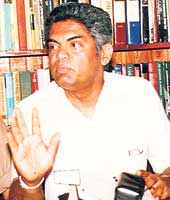
Stop tinkering with our educationMy choice of topic for this Oration was inspired by some of the lesser known achievements of Mr Lalith Athulathmudali - those initiated while he briefly held the portfolio of Minister of Education and Higher Education during 1990-91. My former colleagues at the Ministry used to often quote the visionary Reforms he attempted to introduce into the system.They still speak glowingly of how they looked forward to the intellectually enriching weekly meetings he held to brain-storm new policy.
Lalith Athulathmudali was a visionary. He thought far ahead and had a mature worldview on education. He understood that education was the key to economic progress and he referred to it as ‘the vehicle that carries the antidote to poverty’. He also stressed that; at the core of education development should be pluralism, which embraced a multi-ethnic, multi-religious and multi-cultural character. This, he said was essential, to a country like ours. As a student, he shone in intellectually superior academic environments like Oxford and Harvard. As a university teacher, he taught under similar challenging circumstances in Tel Aviv and Singapore. In the Education Sector, I consider as his most significant achievements, the following:
Although Mr Athulathmudali’s vision for education was based on modernism, he primarily drew inspiration from the ideals of the legendary Dr. Kannangara who believed in and promoted equity and social justice. Mostly, Mr Athulathmudali championed depoliticising education, freeing it from petty and quibbling party politics and he was one of very few Ministers to keep that promise.
Sadly, his lofty attempts could not have a lasting impact on our system. His tenure was too brief and his tragic exit from politics and life brought to a closure all attempts at Reform during that period. Today 14 years after the assassination of Lalith Athulathmudali, I am honoured to deliver this oration instituted in his memory. Education Reform is an emotive subject which is intimately entwined in politics. And this is not a phenomenon unique to SriLanka. It is seen in most parts of the world, where Governments declare their intention to change systems of education. In Sri Lanka we have witnessed attempts at Reform from the Kannangara era (1931-1947), Dr. Udagama’s tenure (1971), President J. R. Jayawardene’s White Paper 1981, and finally the Education Reform agenda of President Kumaratunge’s administration during the last decade. Why education reform? Sri Lanka has been celebrated as having high education achievements and learning, when compared to other countries in South Asia. This reputation has been largely built on the high literacy levels and the high levels of primary school enrolment, as well as gender parity in education access and achievements. In fact we are often lauded at international forums, for being one of the very few nations from the developing world to have come close to reaching the Millennium Development Goals (MDGs) as well as the Goals set out by Education for All (EFA) - both programmes initiated and pursued by the United Nations. We are commended for enjoying a high place in the Human Development Index (HDI), despite being a country with a middle level income. However, when describing our achievements, we often choose to ignore our failures and the serious gaps in the system i.e,
2-3%of GDP
1997 - Year of Education Reform In my presentation today, I intend speaking of the attempts that were made and the failures encountered in introducing changes to education policy during 1995-2005. This is a period about which I can speak first hand, since it was during this period that I held responsibilities in the National Education Commission and the Ministry of Education. The vision of the Government at the time was to modernise the education sector, to make it relevant to the contemporary needs of the 21st century, in keeping with global changes in education. The core principles of this programme were:
I will highlight some of the key initiatives introduced within these categories and the issues that we faced during implementation. Curricula Reform and Modernisation This was based on the imperative to shift from rote learning and didactic teacher-centred teaching, to student-based-learning, where activities and projects were introduced from the primary classes upwards. The new primary curriculum, organised through Ky Stages 1, 2&3, was integrated and activity-based, where children learnt through play. Activity-based-Oral English a new subject introduced for the first time, enabled 5 year olds to learn a few English words during school hours. This was coupled with introducing English Language at Grade 3. These moves were largely welcomed by parents.
Intensive and structured teacher training preceded the introduction of the new curriculum in the different Grades. Upgrading and modernising text books Modernising text books was a key component of the Reform programme. The out-dated, drab and monotonous books given free to children were written either by the National Institute of Education (NIE) or the Education Publications Department (EPD). These books, for some years, have been in want of factual accuracy and sometimes neglected ethnic and religious sensitivities. This had led to controversy and intense political debate. In the search for excellence in books, the Ministry introduced a Multiple Book Option (MBO), a practice widely used internationally. Through the MBO, a wider choice of books was made available and schools were given multiple options for each subject. Both local and reputed international writers and publishers of books were invited to bid, in an open and transparent manner. They were to produce books in accordance with the syllabuses prescribed by the NIE of the Ministry. It was hoped that the element of competition would lead to higher standards and better quality of books. Subject Specialist Panels appointed by the EPD were mandated to approve the manuscripts prior to awarding the tenders. Children and teachers welcomed these new books which were undoubtedly of superior quality. This method was in operation until the end of 2005, but has now been abandoned; reverting back to the old system where there are no options in book selection.The monopoly of book writing and publishing once more is vested with the NIE and the EPD of the Ministry. Examination reforms Key reforms were introduced into the three public examinations (Grade 5 scholarship exam, O’Level and A’ level) based on the recommendations by expert committees:
Grade one admissions 2005-2006 One of the reasons for the public to lose faith in our education system was the corruption and injustice that prevailed every year with Grade 1 admissions. It was an open secret that irregularities in the selection process took place at the school level as well as at the Ministry/Provincial level. The degree of political interference in this matter is also well known. Even honest officials and administrators are powerless in decision making. Due to political pressures the Secretary to the Ministry has to often violate the School Admissions Circular that he himself signs! Having studied the problem in depth and after having gone through series of consultative processes through the National Education Commission for many years, a new system for processing applications for the popular 325 National Schools was devised. This scheme did not in any way tamper with the quotas allocated for children who lived near the school (the ‘area rule’) or had siblings attending the school or had parents who had attended that school. The innovation was to make the application process transparent from the very beginning. By feeding the applications into the computer using specially designed soft ware, and by posting the results on the web site at every stage of the selection. Those children who were eligible, short listed, and those who were eventually selected knew to what school they had gained entry. There was no mechanism to surreptitiously include a candidate who did not meet the required criteria. Nor was there room for political and other influences to creep in. This was primarily because the new system ensured transparency from the word ‘go’. Small class size and teacher: pupil ratio The necessity to restrict Grade 1 class size to 40 (although the internationally accepted norms are between 25-30), so that reasonably healthy teacher: pupil ratios could be maintained was also insisted upon. The futility of trying to implement a child-centred primary curriculum with classes that were overflowing with 50-55 children, where the teacher could hardly see, let alone interact with the child, was highlighted by all the educationists who worked on the Primary Reforms. The President, who was also the Minister of Education at the time, informed all Government MPs and Provincial politicians to not interfere with this initiative, allowing the officials to handle the process, as per the legal circulars. The time table for the application process was advertised in the media and it was adhered to. For the first time an admission process that was free of corruption and where deserving children got places in prestigious schools despite social class, took place. At the same time courageous measures were adopted to address issues of corruption in the admission process in the previous years and this led to the interdiction of several school principals.However this entire scheme was done away with and the Operations Room for School Admissions, equipped with computers and trained staff was dismantled during early 2006. Other initiatives
For the past so many years, the tragedy of the Higher Education system has been that less than 3% of the relevant age cohort and less than 15% of those who qualify at A’level, can secure placements in universities. This has made Sri Lanka one of the countries with the poorest rates of higher education enrolment.
The 15 state-owned, state-funded and state-managed universities in 2006, could offer only 17,287 places to the 119,555 students who qualified. Moreover, these universities can hardly meet the required quality that we see in reputed universities elsewhere. They ceased to be halls for intellectual inspiration and academic strength long ago. To be continued next week......! |
|| Front
Page | News | Editorial | Columns | Sports | Plus | Financial
Times | International | Mirror | TV
Times | Funday
Times || |
| |
Reproduction of articles permitted when used without any alterations to contents and the source. |
© Copyright
2007 | Wijeya
Newspapers Ltd.Colombo. Sri Lanka. All Rights Reserved. |

